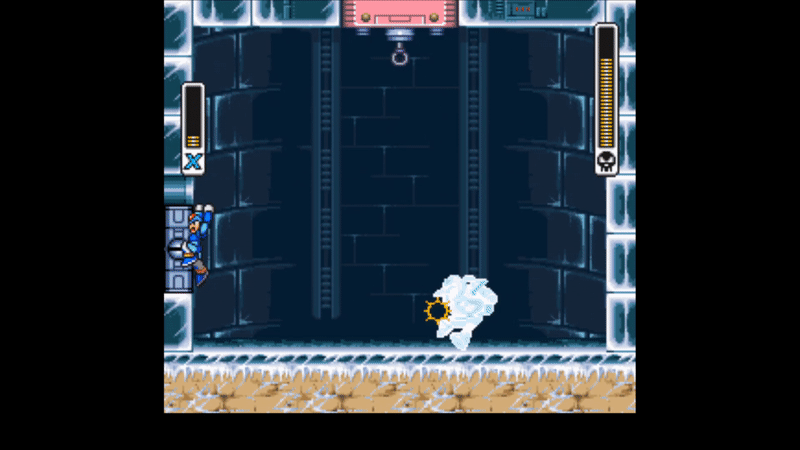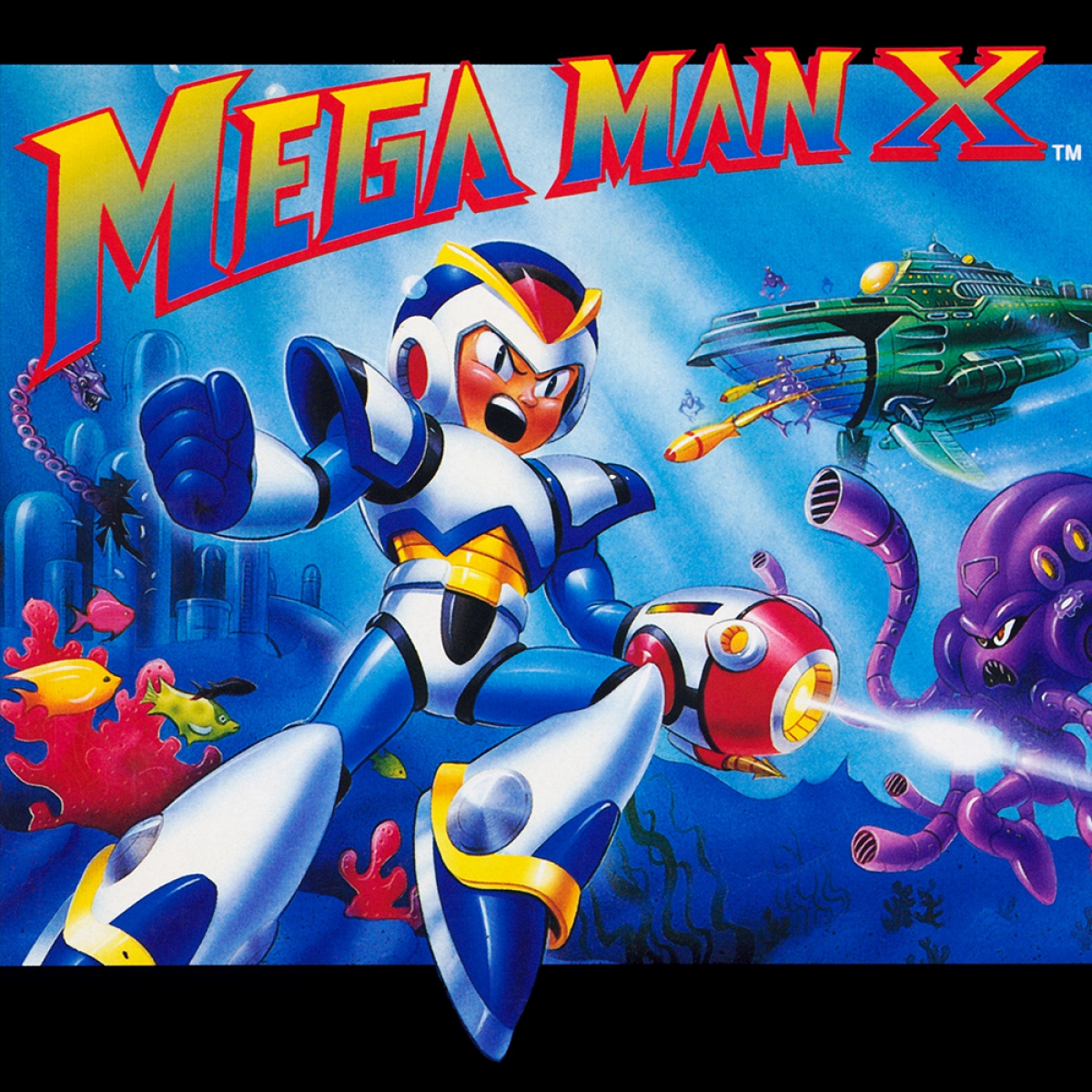Mega Man X, released in 1993 for the Super Nintendo Entertainment System, marked a big step forward for its sister-series Mega Man, as well as for 2D action games in general. It’s a game about robots, fighting robots, with cool weapons and powers. The protagonist of Mega Man X was cooler, sleeker, just a liiiiiiiittle bit more Bladerunner (maybe like 10%) and slightly less Astro Boy. The titular Mega Man X was made to be stronger, faster, more capable than his older predecessor. Nowhere was this made more apparent than in the movement system, which included two new movement mechanics, the Dash, and the Wall Jump.
The fighting robot Mega Man, starting with Mega Man 3, is able to slide, which changes his hitbox for registering enemy attacks to a wider, shorter rectangle, meaning it could be used to dodge certain projectiles, while also making him move slightly faster in quick bursts. The Mega Man X dash was an evolution of this, retaining the change in hitbox while also greatly magnifying the speed of the ability. It was made more powerful in that sense, but also made more generally useful with an additional technique. Jumping out of the Mega Man X Dash would allow the player to clear greater distances with their jump, as the Dash’s bonus speed would not dissipate until they hit the ground or a wall from said jump.
The protagonist of Mega Man X can jump into a wall, cling to it, and slowly sliding down its length. When jumping from this wall slide, he can gain additional height by jumping off the wall. The interesting thing, is that because of the high degree of aerial maneuverability in this game, it’s possible to change direction mid-air immediately after a wall jump, and reattach to the wall at a higher elevation, effectively allowing the player to climb any vertical surface. This is known as the Wall Kick. 2D action games, obviously, have two axis of movement, though generally one access is rather strictly limited, the vertical axis. The Wall Kick gives a vector of control over this space while maintaining the advantages of limitation through gravity have on the game world. Giving the player a limited method by which they can break the rules of gravity offers the overall design a certain dynamism. The player now has two modes of operation they can switch between on the fly without even thinking about it – aerial oriented and ground oriented.

These two moves, simple though they are, were designed intentionally to be extremely powerful, and extremely dynamic by giving them a huge possibility space with a wide range of use cases. Wall climbing can be used to avoid attacks near the ground, to reach hidden areas, or to get over and behind a troublesome enemy. The dash can be used like a dodge to quickly position the player out of harms way, to clear a level faster by stringing dashes together, or to clear large horizontal spaces with the dash jump. Those are just a few examples. With such a broad range of possibilities, this empowerment of the player greatly raises the skill ceiling of this games, making mastery more rewarding, while broadening what can be done in the design of levels and bosses. It’s the applicability of these moves, in particular that widens the possibility space. Mega Man X can climb any vertical surface, and dash at any time. Because these moves are always available, the game needs to be designed with them always in mind.
From here, bosses start to incorporate this possibility space into the overall plan. If a player is made more powerful, in this case given a broader degree of control over their position in 2D space, then the environment needs to be designed to both accommodate and interact with that power. You’ll notice a lot more verticality in the level design of Mega Man X over Mega Man. Trees, tall buildings, and aircraft are common. The original series did play with vertical movement from time to time, but mostly in the form of moving platforms and falling – not things the player had much control over.

With this added degree of control comes added obstacles. A Mega Man game in which enemies never posed a threat to you while wall-climbing would mean losing the game’s notable blend of combat and traversal for the sake of this new mechanic. Rather than make it incongruous, the Wall Kick feels like a natural extension of Mega Man‘s movement systems, that flows with the established gameplay. What’s more, by introducing threats and problems to solve in the context of using the Wall Kick, the Wall Kick is made to have functional, practical application in and out of combat.

I know the title of this piece says Mega Man X, but the Mega Man series, overall shows an increasing level of acuity when it comes to making use of the Wall Kick and Dash abilities. The story and general gameplay aesthetic of Mega Man X continued on to the Gameboy Advanced Mega Man Zero titles, as well as the Nintendo DS Mega Man ZX titles, which are direct sequels to the Mega Man X series, despite the change in subtitle. Faster and snappier than ever in both control and combat design, they really illustrate the limits to which the Wall Kick and Dash can really push Mega Man. Mega Man X itself has some fun and memorable bosses, but they only scratch the surface of how the new movement can be leveraged to make new and more interesting boss encounters. X and others like him will find themselves climbing walls to reach weak points, ducking projectiles, and clashing with inhumanly fast foes as the series goes on.

Bosses like Deathtanz Mantisk (which, incidentally, may be the single best name for a boss enemy in any video game ever made. I’m serious. Just, try saying it out loud. You’ll see.) utilize vertical space in really interesting ways, creating a counterpoint to the player’s ability to climb walls. Now not only can the player climb walls, which is fun, but they can outmaneuver their foes by doing so, which is fun and empowering! When this terrifying death-robot zooms across the screen, narrowly missing Mega Man Zero with a razor-sharp scythe blade, as the player readjusts their position with a dash, the sensation of taking part in a sci-fi-anime-robot-battle becomes very real. A high-powered player character creates high-powered situations, if the enemy and level design rises to meet these elevated powers.

The best part of all of this is that Dashing augments the Wall Kick, meaning both of these maneuvers can be used in concert to an even more powerful effect. Using to verticality to your advantage is powerful. Moving great distances in quick bursts is powerful. So, moving great distances in quick bursts through vertical space is extremely powerful. Mega Man is able to populate its many entries with some of the most visually impactful and fluidly playing boss encounters in the business leveraging the possibilities allotted by this high level of player power. Growing up on these games, they’ve had a big influence on me, and I tend to, when designing, leaning towers player empowerment. The more powerful a player is, in a practical and broadly applicable way, the more room there is in the design to do crazy and surprising stuff with environmental and enemy encounters. Because Mega Man can traverse so much vertical space so easily, there needs to be wild, sprawling vertical spaces filled with interesting things to see and do, things that wouldn’t be possible if he were more strictly adhered to the ground. There’s something to be said for more limited player power depending on the overall design goals, of course, but Mega Man very succinctly shows the design advantages of allowing the player a great deal of power.

The simple combination of a dash and a powerful yet limited method for traversing vertical space has become an extremely effective tool for 2D action games in creating elaborate and spectacular combat systems. It’s no surprise to see surprise to see spins on it utilized in such titles as Hollow Knight, Azure Striker: Gunvolt, and Super Meat Boy. It’s just a very elegant way to give the player a way to leverage the huge amount of air control they have in those games for interesting combat and traversal scenarios. Metroid has been exploring its own take on this concept to similar effect since 1991, actually two years prior to the release of Mega Man X, but no series has quite so thoroughly explored its possibilities as that of the blue bomber.

You may even become as powerful as I am…
